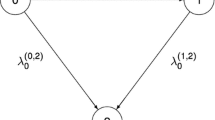Abstract
In biostatistical applications interest often focuses on the estimation of the distribution of time T between two consecutive events. If the initial event time is observed and the subsequent event time is only known to be larger or smaller than an observed monitoring time C, then the data conforms to the well understood singly-censored current status model, also known as interval censored data, case I. Additional covariates can be used to allow for dependent censoring and to improve estimation of the marginal distribution of T. Assuming a wrong model for the conditional distribution of T, given the covariates, will lead to an inconsistent estimator of the marginal distribution. On the other hand, the nonparametric maximum likelihood estimator of FT requires splitting up the sample in several subsamples corresponding with a particular value of the covariates, computing the NPMLE for every subsample and then taking an average. With a few continuous covariates the performance of the resulting estimator is typically miserable.
In van der Laan, Robins (1996) a locally efficient one-step estimator is proposed for smooth functionals of the distribution of T, assuming nothing about the conditional distribution of T, given the covariates, but assuming a model for censoring, given the covariates. The estimators are asymptotically linear if the censoring mechanism is estimated correctly. The estimator also uses an estimator of the conditional distribution of T, given the covariates. If this estimate is consistent, then the estimator is efficient and if it is inconsistent, then the estimator is still consistent and asymptotically normal. In this paper we show that the estimators can also be used to estimate the distribution function in a locally optimal way. Moreover, we show that the proposed estimator can be used to estimate the distribution based on interval censored data (T is now known to lie between two observed points) in the presence of covariates. The resulting estimator also has a known influence curve so that asymptotic confidence intervals are directly available. In particular, one can apply our proposal to the interval censored data without covariates. In Geskus (1992) the information bound for interval censored data with two uniformly distributed monitoring times at the uniform distribution (for T has been computed. We show that the relative efficiency of our proposal w.r.t. this optimal bound equals 0.994, which is also reflected in finite sample simulations. Finally, the good practical performance of the estimator is shown in a simulation study.
Similar content being viewed by others
References
P. J. Bickel, A. J. Klaassen, Y. Ritov and J. A. Wellner, Efficient and Adaptive Inference in Semi-parametric Models, Johns Hopkins University Press: Baltimore, 1993.
I. D. Diamond, J. W. McDonald and I. H. Shah, “Proportional hazards models for current status data: application to the study of differentials in age at weaning in Pakistan,” Demography vol. 23 pp. 607–620, 1986.
I. D. Diamond and J. W. McDonald, The analysis of current status data, in Demographic Applications of Event History Analysis, J. Trussell, R. Hankinson, and J. Tilton (eds.), Oxford: Oxford University Press, 1991.
S. van der Geer, Asymptotic normality in mixture models, University of Leiden, the Netherlands, preprint, 1994.
R. Geskus, “Efficient estimation of the mean for interval censoring case II.” Technical University Delft, the Netherlands, Technical report 92-83, 1992.
R. D. Gill, M. J. van der Laan and J. M. Robins, “Coarsening at Random; Characterizations, Conjectures and Counter-examples,” in Proceedings of the Seattle Symposium in Biostatistics, 1995, to appear.
P. Groeneboom and J.A. Wellner, Information Bounds and Nonparametric Maximum Likelihood Estimation, Birkhäuser Verlag, 1992.
W. Härdle, Applied Nonparametric Regression, Econemetric Society Monographs No. 19, Cambridge University Press, New York.
T. J. Hastie and R. J. Tibshirani, Generalized Additive Models, Chapman and Hall: London, 1990.
J. Huang and J. A. Wellner, “Asymptotic normality of the NPMLE of the mean for interval censored data, case I,” submitted to Statistica Neerlandica, 1994.
N. P. Jewell and S. C. Shiboski, “Statistical analysis of HIV infectivity based on partner studies,” Biometrics vol. 46 pp. 1133–1150, 1990.
N. Keiding, “Age-specific incidence and prevalence (with discussion),” J. Roy. Statist. Soc. Sec, Ser. A vol. 154 pp. 371–412.
M. J. van der Laan and A. Hubbard, “Estimation with interval censored data and covariates,” Technical report # 61, Group in Biostatistics, University of California, Berkeley, 1996.
M. J. van der Laan, Robins, “Locally efficient estimation with current status data and high-dimensional covariates,” revised for publication in JASA, 1996.
M. J. van der Laan, P. J. Bickel and N. P. Jewell, Singly and doubly censored current status data: estimation, asymptotics and regression, to appear in Scandinavian Journal of Statistics, 1996.
J. M. Robins and A. Rotnitzky, “Recovery of information and adjustment for dependent censoring using surrogate markers,” Aids Epidemiology, Methodological Issues, Birkhäuser, 1992.
J. M. Robins, “Information recovery and bias adjustment in proportional hazards regression analysis of randomized trials using surrogate markers,” in Proceedings of the Biopharmaceutical Section, American Statistical Association, pp. 24–33.
B. W. Silverman, Density Estimation, Chapman and Hall, 1986.
S. C. Shiboski and N. P. Jewell, “Statistical analysis of the time dependence of HIV infectivity based on partner study data,” JASA vol. 87 pp. 360–372, 1990.
Author information
Authors and Affiliations
Rights and permissions
About this article
Cite this article
van der Laan, M., Hubbard, A. Estimation with Interval Censored Data and Covariates. Lifetime Data Anal 3, 77–91 (1997). https://doi.org/10.1023/A:1009620319159
Issue Date:
DOI: https://doi.org/10.1023/A:1009620319159




